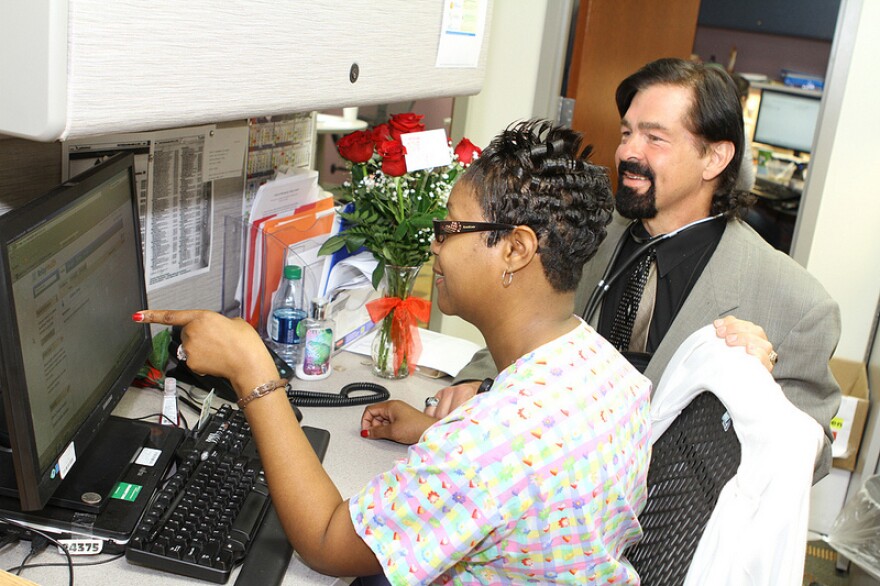Rebecca Yanes recently joined an elite club. It’s not a club she wanted to join. In fact, it’s one that some health professionals across Colorado and the country are working to shut down.
Yanes, 54, exemplifies the 1 percent of the U.S. population that is spending 30 percent of the money that feeds the country’s health care system.

The Colorado woman’s nightmare began last Christmas, when she cut her foot. It didn’t appear to be a serious injury, she said. But Yanes, who is diabetic, went to the hospital emergency room. A doctor treated it and sent her home. On New Year’s Eve, Yanes noticed pus around the wound. Another emergency room doctor treated it, and sent her home. The wound didn’t heal. Over the course of the next several weeks the infection spread, resulting in repeated emergency room visits.
“A day before Valentine’s Day, they took my toes,” Yanes said. The operating doctor casually notified her, as they were prepping her for the surgery, that he would be amputating, she said.
“He said, ‘you know we’re going to have to remove some of your toes, right?’ ” Yanes said.
After the operation, Yanes became very depressed. She didn’t want to leave her bedroom. And she mourned the loss of her toes. Ultimately, Yanes’s situation was brought to the attention of a group of professionals in Aurora who are health care hot-spotting – that is, working with patients who are falling through the cracks, receiving incomplete or inconsistent care.
With the help of a team of medical professionals, including a psychotherapist, Yanes says she was ultimately able to mentally reconcile the loss of her toes. She is physically healing as well.
“Hot-spotting is really looking at data and targeting a geographic area,” said Eliana Mastrangelo of Together Colorado, a community-organizing group. “Also, targeting the folks who are the highest utilizers. Who are those high cost, high needs patients ... who need the most help?”
The term was originally coined to describe the work done by Dr. Jeffrey Brenner, a general practice physician in Camden, N.J. Using data and working in teams, medical professionals identify the sickest patients who are costing the most money, and work with them to reduce unnecessary emergency room visits and hospital stays. Brenner’s model is now being replicated in many parts of the country, including in Aurora and other parts of Colorado.
“The sickest one percent of us are responsible for 30 percent of the costs,” Brenner said during a recent trip to the state. “And by and large, we ignore those patients. We ignore them and move them around our health care system in incredibly inefficient ways.
“We’re going to have to think about how we’re using our money, because good care does not look like what we have now.”
In 1960, health care expenditures in the United States accounted for five percent of the gross national product. That figure has ballooned to 18 percent – far more than any other major industrialized country.
According to the U.S. Department of Health and Human Services, in 2004 the United States spent $1.9 trillion on health care. That averaged out to about $6,280 a year for each man, woman, and child. By last year the cost has risen to $8,233 per person every year.
A study completed by the federal Agency for Healthcare Research has determined that, “actual spending is distributed unevenly across individuals, different segments of the population, specific diseases, and payers.” Among the findings:
- Half of the population spends little or nothing on health care, while 5 percent of the population accounts for almost half of total health care expenses.
- The 15 most expensive health conditions account for 44 percent of total health care expenses.
- Patients with multiple chronic conditions cost up to seven times as much as patients with only one chronic condition.
In the year since Dr. Mark Wallace began hot-spotting in northern Colorado, he said thousands of patients have been contacted via phone and personal contact.
Wallace, chief medical officer of the North Colorado Health Alliance, said he recently hired a business analyst to help determine a dollar amount that has been saved from the work his group has been doing. But he described one scenario to underscore a real example of cost savings – and an improvement in the quality of life for one patient.
The patient, he said, was a woman whose weekly emergency room visits grew to 30. In addition, she had been hospitalized several times. Estimating just the ER visits at $1,500 each, the cost was $45,000, Wallace said. When Wallace’s organization launched their hot-spotting program, the woman landed at the top of the list.
“We were able to take her from using the ER over 30 times to not having an ER visit,” he said. “And over eight months and we were able to reduce her hospitalization to zero.”
Wallace recently expanded from Weld and Larimer counties into rural Yuma and Washington counties. He said medical professionals from across Colorado have contacted him for pointers to help them replicate efforts in other parts of the state.
“We’re sharing information with anyone who comes to visit,” he said.







